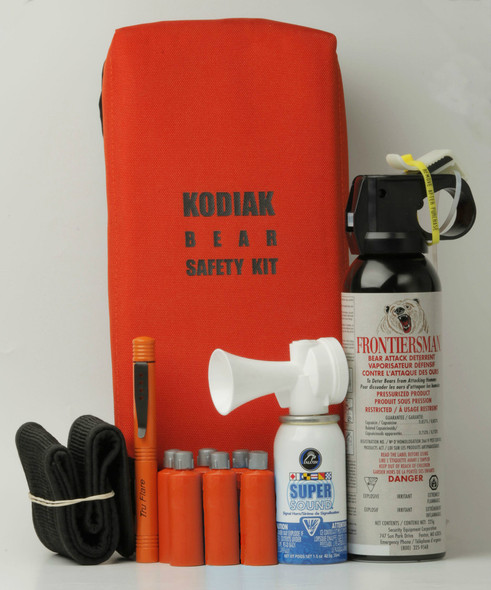Effective Bear Safety: Partnerships, Training, And Bear Spray Distribution

Table of Contents
Strategic Partnerships for Enhanced Bear Safety
Effective bear safety isn't achieved in isolation. Strong partnerships are the cornerstone of successful bear management and conflict prevention.
Collaboration with Government Agencies
Government agencies play a vital role in bear safety. Wildlife departments and park services possess the expertise and resources to implement large-scale initiatives.
- Data Sharing: Agencies can share crucial data on bear activity, enabling better prediction of potential conflicts.
- Joint Public Awareness Campaigns: Collaborative campaigns reach broader audiences and create consistent messaging on bear safety practices.
- Coordinated Response Plans: Well-defined plans ensure efficient and effective responses to bear incidents, minimizing risk to both humans and bears.
- Habitat Management: Government agencies can implement measures to manage bear habitats, reducing human-wildlife interaction.
Engaging Local Communities
Local communities are on the front lines of bear encounters. Their active participation is crucial for effective bear safety.
- Community Workshops: Workshops educate residents on coexisting with bears, including proper food storage and waste management.
- Educational Programs: Schools and community centers can implement age-appropriate programs to foster bear awareness from a young age.
- Volunteer Initiatives: Volunteers can help distribute bear-resistant garbage cans and participate in bear monitoring programs.
- Citizen Science Projects: Community involvement in bear monitoring provides valuable data for research and management.
Collaboration with Businesses
Businesses operating in bear country have a responsibility to promote bear safety. Tourism operators and outfitters, in particular, must prioritize safety.
- Staff Training: Businesses should provide comprehensive bear safety training to all staff interacting with the public in bear habitats.
- Bear-Safe Practices: Implementing bear-safe practices, such as proper food storage and waste management, minimizes attractants.
- Responsible Wildlife Viewing: Promoting responsible wildlife viewing practices minimizes disruption to bear behavior and reduces the risk of encounters.
- Financial Support: Businesses can support bear safety initiatives through donations or sponsorships.
Comprehensive Bear Safety Training Programs
Education is paramount to fostering effective bear safety. Comprehensive training programs must target various audiences.
Educating the Public
Public education campaigns are vital for raising awareness about bear safety and responsible behavior.
- Informative Brochures: Easy-to-understand brochures offer practical tips for avoiding bear encounters.
- Educational Websites and Videos: Engaging online resources provide accessible information to a wider audience.
- School Programs: Integrating bear safety into school curricula educates the next generation.
- Community Outreach Events: Interactive events provide opportunities for direct engagement and question-and-answer sessions.
Training for Professionals
Professionals who regularly interact with bears, such as park rangers and wilderness guides, require specialized training.
- Advanced Bear Safety Courses: In-depth courses cover bear behavior, conflict avoidance, and emergency response protocols.
- Wilderness First Responder Training: This training equips professionals to handle injuries resulting from bear encounters.
- Emergency Response Protocols: Clear protocols ensure efficient and coordinated responses to bear incidents.
- Defensive Tactics (Bear Spray): Proper training on the effective use of bear spray is crucial.
Developing Effective Bear Awareness Programs
Effective programs adapt to specific locations and target different demographics.
- Family-Focused Programs: Programs tailored to families emphasize child safety and responsible behavior in bear country.
- Hiker and Camper Education: Specific guidance on food storage and campsite safety is vital for these groups.
- Interactive Tools: Using engaging methods like games and simulations boosts knowledge retention.
- Location-Specific Adaptations: Programs should consider the unique characteristics of the region and bear species present.
Effective Bear Spray Distribution and Usage
Bear spray is a highly effective deterrent against bear attacks, but its accessibility and proper use are critical.
Accessibility of Bear Spray
Making bear spray readily available and affordable increases its effectiveness.
- Retail Partnerships: Collaborate with retailers to ensure widespread availability in outdoor stores and visitor centers.
- Subsidized Programs: Offer subsidized programs to make bear spray accessible to low-income communities.
- Strategic Placement: Place bear spray in high-traffic areas like visitor centers and trailheads.
Proper Training on Bear Spray Usage
Knowing how to use bear spray correctly is crucial.
- Hands-on Training: Practical training sessions allow individuals to practice deploying bear spray.
- Demonstration Videos: Visual aids provide clear instructions on how to carry, deploy, and maintain bear spray.
- Clear Instructions: Simple, unambiguous instructions eliminate confusion during emergencies.
Addressing Myths and Misconceptions
Addressing common misconceptions about bear spray is essential for promoting its effective use.
- Debunking Myths: Clearly address false beliefs regarding effectiveness, environmental impact, and safety concerns.
- Scientific Evidence: Provide scientific evidence demonstrating bear spray's efficacy as a deterrent.
- Environmental Impact: Address concerns about the environmental impact of bear spray, using readily available information on the minimal ecological impact.
Conclusion: Prioritizing Effective Bear Safety for a Safer Coexistence
Improving bear safety requires a comprehensive strategy encompassing strong partnerships, robust training programs, and the responsible distribution and use of bear spray. By working together – government agencies, local communities, businesses, and individuals – we can create a safer environment for both people and bears, fostering a peaceful coexistence. We encourage you to learn more about effective bear safety practices, participate in training programs, and support initiatives that enhance bear safety measures in your community. Promoting effective bear safety strategies is a shared responsibility that contributes to a more harmonious relationship with wildlife.

Featured Posts
-
 Ronaldo I Kho Lund Imitatsi A Na Slav Eto I Reaktsi Ata Na Cr 7
May 22, 2025
Ronaldo I Kho Lund Imitatsi A Na Slav Eto I Reaktsi Ata Na Cr 7
May 22, 2025 -
 Trumps Tax Plan Will A Divided Gop Deliver
May 22, 2025
Trumps Tax Plan Will A Divided Gop Deliver
May 22, 2025 -
 Danh Gia Cac Du An Ha Tang Giao Thong Then Chot Tp Hcm Binh Duong
May 22, 2025
Danh Gia Cac Du An Ha Tang Giao Thong Then Chot Tp Hcm Binh Duong
May 22, 2025 -
 Finansoviy Reyting 2024 Uspikh Credit Kasa Finako Ukrfinzhitlo Atlani Ta Credit Plus
May 22, 2025
Finansoviy Reyting 2024 Uspikh Credit Kasa Finako Ukrfinzhitlo Atlani Ta Credit Plus
May 22, 2025 -
 Lancaster County Crash Pilots Son Released From Burn Center
May 22, 2025
Lancaster County Crash Pilots Son Released From Burn Center
May 22, 2025
